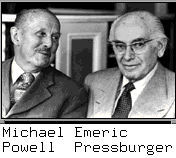Editing in the films of Michael Powell and Martin Scorsese
Just back from Canterbury Christ Church University where Thelma Schoonmaker gave the inaugural Nick Burton Memorial Lecture titled "Editing in the films of Michael Powell and Martin Scorsese"
For those that didn't know him, Nick Burton was the head of the Department of Media at Canterbury Christ Church. When they wanted to reorganise all the buildings there and give them the names of famous people, the original plan was for the Media building to have a name beginning with some other letter of the alphabet. But Nick insisted that it had to begin with a 'P' and be called the Powell Building even if it did disrupt the rest of the scheme.
Nick organised various groups of students to film interviews with surviving members of the cast or crew of P&P films and started the Powell Archive at the college. As well as the various events he organised in Canterbury like the Michael Powell Festival in October 2004 (17 films, conference and exhibition), Nick was also willing to risk making a fool of himself when he came on one of our ACT location walks and he and Prof. Ian Christie were "volunteered" into acting out one of the scenes at the location where they were filmed. Actually they both entered into the spirit of it with gusto and did a great job.
If you have the Criterion DVD of ACT, that's Nick interviewing John Sweet in the Cathedral tea rooms as one of the extras. That was done when John came back to Canterbury in 2000 and met up with Sheila Sim (Lady Attenborough) again for the first time since they'd both been there in 1943/44.
But Nick was sadly stricken and taken from us last year. Having a memorial lecture is a great way to remember him and it was most fitting that Thelma should give the first one as she's done so much for the college and the department. She's having another busy weekend. She was in Canterbury yesterday to be made an honorary Fellow of the University and she had the full honours in the Cathedral, walking up the nave where Michael had walked so many years before. And on Monday she's off to Bath to introduce Raging Bull.
So after yesterday's ceremony I just had to greet her this evening with a "Hail Fellow and well met" :)
The lecture was actually about quite a difficult subject. If an editor has done their job really well then you don't usually notice it. If you do notice it then they usually aren't very good. And remember that Thelma is undoubtedly one of the very best in the world.
She started with a few examples from her own work of occasions where there was hardly any editing necessary, one where there was some discreet editing done and one where there was some outrageous editing. The first one was Henry & Karen's first date in Goodfellas, where they walk into the Copacobana via the back door & through the kitchens with Henry greasing the palm of everyone they pass. That was all done in one shot on a steadicam so although there was a lot for everyone else to set up and get right, it didn't need much editing. The second one was the "You think I'm funny" scene between Tommy & Henry in the same film. That has some subtle editing done to keep everyone in medium shot to catch the reaction of those around them to the rising tension and danger. The third scene was from The Aviator, when Howard Hughes crashes in the XF-11. That involved a lot of CGI because the planes don't exist any more (certainly not in an airworthy state) and things like the wing slicing through a house would be a bit difficult to create for real.
Then she looked at some early influences on Powell & Scorsese, talking us through clips of the plate smashing mutineers from Battleship Potemkin and Sally finding Joe in the basement in A Cottage on Dartmoor. She showed how the Eisenstein film influenced the cutting of the part in Powell's The Phantom Light where the ship nearly crashes on the rocks. And how it also influenced some of the cutting of the first big street battle in Gangs of New York. She also pointed out the flashback and other clever editing in A Cottage on Dartmoor which almost certainly influenced both directors.
Then onto everybody's favourite film (or everybody at Canterbury) showing some of the more unusual editing in A Canterbury Tale. Like the camera flying through the bells under the opening titles, the cutting short of the revealing of Colpeper in the Town Hall, the falcon into the spitfire and Colpeper scything the grass. Then in the same film, the way that when Alison opens the door of the caravan she is moving towards it but there's a sudden jump to a shot of her stationary in the doorway. The classic technique would be to allow her movement to come to a stop before the close up, but that slight jump adds a bit to the surprise and perception of her distress. Of such subtleties are the editors life made.
She showed us some of the footage from the wine advert that she and Scorsese had recently made. She showed us some of the footage as she got it, with the green screen still showing. And then showed how that was made into the final footage either by editing in other scenes or by mattes. Where the man is looking over the balcony and sees the orchestra playing below, we saw him looking over the balcony onto a green screen. The real footage of the orchestra playing in the studio was then cut into that and the rest of the background was filled in from a still of the inside of the real hall - Just like P&P used stills of the inside of Canterbury cathedral as backing for their own re-creation of it in the studio. This may be the era of CGI but sometimes the simplest of techniques can still be the best ones to use. And Marty & Thelma, being such good students of those old techniques, know how to use them all well. Sometimes they do have to use CGI, but Thelma was almost apologetic about their having to do so and said that it was usually too clean. Comparing it to the falcon into Spitfire cut in ACT where it's not a perfect cut, the falcon and the Spitfire are actually flying in opposite directions, but it works beautifully in ACT.
Oh, talking of them being good students, she did mention that they're still working on Scorsese's documentary about British cinema.
Throughout all of these clips, Thelma was explaining many things and cross referencing to lots of other films, not just those of Powell or Scorsese. She finished with another look at ACT, at the scene where Alison is told that Geoffrey is still alive, and she faints. This of course was then compared to Ruth's fainting in BN.
After that she took some questions from the audience. Someone asked which piece of editing was she the most proud of and she replied that it'd still have to be the final fight in Raging Bull. I managed to sneak in and ask the counter to that question and ask which she thought were the ones that got away, that she would most like to have done. She went for Raging Bull again, where Jake and Joey were arguing in the apartment. Because that was filmed in a real apartment, not on an open set, they couldn't get enough cameras in there. She felt she could have done more with more footage to work with. Someone else asked the classic question which she must get asked quite often. How does a genteel lady like her deal with all the violence in Scorsese's films? Thelma pointed out that when she gets the footage it's usually not all that violent, she's the one that makes it seem so violent :)
Much applause and many thanks, especially to Eddie McMillan who organised most of it and pressed all the right buttons for us to see the clips.
Steve
Other P&P trips

